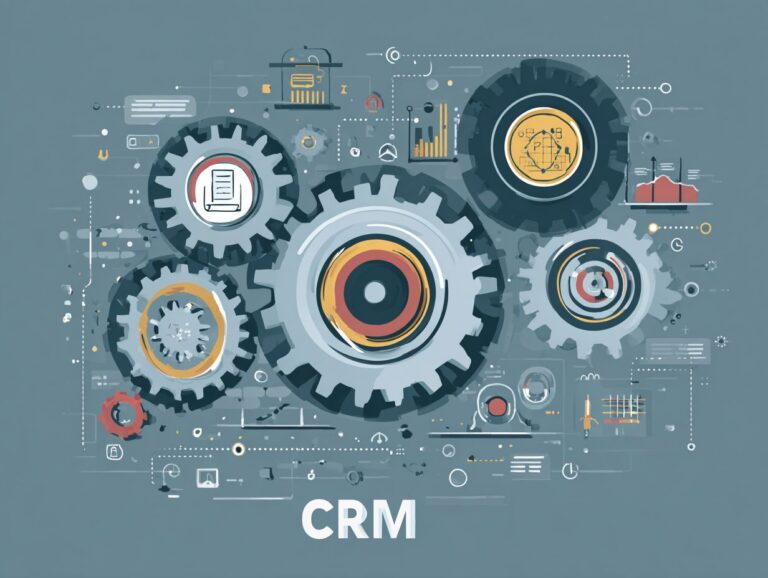CRM Implementation: Key Steps, Strategy, and Best Practices
Using CRM software greatly improves how companies handle customer interactions, leading to increased sales. A clear plan for managing customer relationships improves work efficiency and increases customer happiness. This article discusses the main steps for effectively using a CRM system, why it’s important to match your objectives with the right CRM, and the best ways to achieve lasting success. Use CRM to improve your business today!
Key Takeaways:
- Achieve success in setting up CRM by thoroughly evaluating business requirements and choosing the most suitable CRM system.
- Create a strong CRM plan by setting clear goals and involving key people to increase business success and keep customers happy.
- Use practical methods such as providing training and support, and routinely reviewing and evaluating the CRM system to make sure it functions properly and continues to grow.
- Key Steps in CRM Implementation
- Developing a CRM Strategy
- Best Practices for Successful CRM Implementation
- Frequently Asked Questions
- 1. What are the key steps in a successful CRM implementation?
- 2. What is an effective CRM implementation strategy?
- 3. What are some best practices for CRM implementation?
- 4. Why is a needs assessment important in CRM implementation?
- 5. How can employees be trained for a new CRM system?
- 6. What are the key benefits of a well-implemented CRM system?
1. Importance of CRM in Business

CRM systems make handling customer management easier, leading to a 25% improvement in customer retention for businesses that fully use these systems.
Businesses can use CRM systems like Salesforce and HubSpot to better manage customer interactions by sending personalized messages and prompt follow-ups.
Salesforce’s AI tools look at customer data to give helpful information, speeding up response times by as much as 40%. Businesses using HubSpot experience a 30% increase in how happy their customers are because it offers fast help through automatic processes.
These improvements increase customer loyalty and lead to an average revenue growth of 15% annually, demonstrating the results of successful CRM implementation. Worth exploring: Boost Sales and Retention with Effective Customer Experience Marketing.
2. Overview of CRM Systems
Modern CRM systems like Dynamics 365 and Pipedrive provide online tools that give useful customer details and better manage data. These CRM platforms excel in different aspects.
For example, Dynamics 365 is a good choice for large companies, integrates effectively with other Microsoft tools, and offers thorough data analysis and reporting capabilities. Pipedrive, starting at around $12/month, appeals to smaller teams with its user-friendly interface and sales pipeline management features.
HubSpot and similar tools offer free versions with basic features, which are great for new businesses. When choosing, consider your team’s size, budget, and specific needs, ensuring the selected system supports scalability as your business grows. Related insight: How customer experience can be enhanced by technology.
Key Steps in CRM Implementation
Having a clear plan for setting up CRM can reduce problems in merging systems and make sure they work smoothly with company operations. This approach aligns with the principles outlined in our guide on customer experience guidelines.
1. Assessing Business Needs
Assessing business needs involves gathering data through surveys and stakeholder interviews to identify specific CRM requirements and measurable objectives.
- Begin by creating a survey using tools like SurveyMonkey, targeting key user groups. Ask questions that reveal both needs and challenges related to CRM features.
- Next, organize interviews with managers to understand their ideas for the CRM project. Together, you can define measurable objectives, such as reducing response times or improving customer retention by a specific percentage.
- Working together helps everyone share their opinions, making it easier to correctly evaluate your CRM needs.
2. Selecting the Right CRM Solution
Choosing the right CRM solution requires evaluating options based on functionality, integration capabilities, and budget considerations to avoid cost overruns. Begin by identifying your primary needs, such as lead management, reporting, or customer support features.
For example, Salesforce offers several ways to customize and simplify tasks, but it costs $25 per user each month, so it’s better suited for larger teams. HubSpot, with a free tier, shines in user-friendly interfaces and marketing tools, ideal for small businesses.
Meanwhile, Dynamics 365 integrates smoothly with Microsoft products, making it a great choice for companies that already use them. Look at how each choice matches your business needs to make a wise investment.
3. Data Migration Strategies

Good data migration methods make sure that customer data is moved correctly to the new CRM system, keeping it usable and accepted by users.
Begin by carrying out a detailed data cleanup to eliminate duplicates and unnecessary records. Use tools like Talend for the extraction, transformation, and loading (ETL) process, which can make this workflow much easier.
Next, match your current data fields to the new CRM structure to make sure they work together. Following that, run a validation test on a small sample to check for errors.
The time needed for this process varies with the data size, taking anywhere from a few days to a few weeks, as each step is done carefully.
Developing a CRM Strategy
A good CRM plan is important for aligning system features with business goals and getting employees to accept it throughout the company.
1. Defining Objectives and Goals
Setting clear objectives for using CRM can create measurable ways to track success and plan ahead.
- Start by establishing specific goals such as increasing sales conversion rates by 15% within six months or improving customer retention rates by 10% in a year.
- Use the SMART criteria to make sure every goal is clear, can be tracked, realistic, important, and has a deadline. For example, if you want to increase customer interaction, set a goal to send monthly newsletters to 60% of your active users.
- Tools like Salesforce or HubSpot can track these measurements and change strategies using real-time data, encouraging ongoing improvement.
2. Engaging Stakeholders
Involving stakeholders at the beginning of the CRM project encourages shared responsibility and makes sure the system matches what users need.
- To maximize stakeholder engagement, initiate regular meetings to discuss project goals and gather feedback.
- Use tools like Slack or Microsoft Teams for regular communication, ensuring everyone feels included and informed.
- Share progress updates through visual project boards with software like Trello or Asana, allowing stakeholders to track milestones easily.
- Make surveys or polls to collect feedback on user experiences, allowing changes that improve how users accept the system.
By actively including stakeholders, you build trust and create shared ownership of the CRM system.
Best Practices for Successful CRM Implementation
Following established methods when setting up CRM systems helps businesses get more users on board and avoid typical mistakes.
1. Training and Support

Thorough training and continuous help are important to make sure people use the CRM system and get the most out of their investment.
To implement an effective training plan, start with initial sessions through platforms like Udemy, focusing on CRM functionalities and best practices.
After these steps, organize question-and-answer sessions every two weeks to address particular user problems and provide information from integration partners.
Encourage users to participate in forums or community groups for peer support. Use resources like instructional videos and step-by-step guides to help with learning. This mix of organized training and continuous interaction will build confidence and skill in your team.
2. Monitoring and Evaluation
Creating a dependable method to evaluate and update your CRM setup is important for checking how well it works and making needed changes.
To do this effectively, start by defining key performance indicators (KPIs) such as lead response time, customer satisfaction scores, and conversion rates.
Use tools like Google Analytics for website traffic analysis and HubSpot for tracking engagement scores. Regularly generate reports (monthly or quarterly) to analyze the data trends. This will show what your team does well and what needs work, allowing them to quickly change strategies and improve CRM results.
3. Future Trends in CRM
Recent changes, like combining AI and better ways to gather user feedback, are altering how CRM systems will work.
As companies use more AI-based data analysis, they can learn more about how customers act. Tools like HubSpot and Salesforce now use AI features to simplify data analysis, giving practical suggestions to improve client engagement.
Integrating CRM systems with cloud-based tools, such as Slack and Google Workspace, facilitates seamless communication and collaboration across teams. This integration improves access to data and allows updates instantly, so customer interactions are always informed and on time.
Frequently Asked Questions
1. What are the key steps in a successful CRM implementation?
The main steps for a successful CRM setup are: doing a detailed check of what you need, choosing the right CRM software, defining clear goals, creating a strong plan to put it in place, training staff, and regularly checking and assessing the system for better results.
2. What is an effective CRM implementation strategy?

An effective CRM implementation strategy should involve a strong focus on customer needs and communication, thorough data management and integration, aligning the CRM with existing business processes, and creating a culture of adoption and dedication to the system.
3. What are some best practices for CRM implementation?
Some effective steps for setting up CRM involve including important team members in decisions, correctly managing and training staff, keeping data correct and reliable, checking and updating the system regularly, and connecting the CRM with other business tools for smooth operations.
4. Why is a needs assessment important in CRM implementation?
A needs assessment is important in CRM implementation as it helps identify the specific pain points and challenges facing the organization, and allows for the selection of a CRM software that best fits those needs. It also helps establish clear goals and objectives for the system, leading to a more successful and smooth implementation process.
5. How can employees be trained for a new CRM system?
Employees can be trained for a new CRM system through a combination of online and in-person training, as well as providing access to user manuals and video tutorials. Hands-on experience and regular refresher courses can also help to reinforce the learning and increase adoption of the system.
6. What are the key benefits of a well-implemented CRM system?
A properly used CRM system can lead to higher customer satisfaction, more sales and income, better handling and study of data, smoother business operations, and clearer knowledge of customer habits and needs for focused marketing plans.





